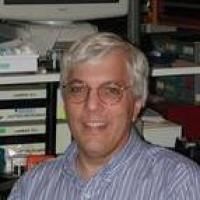Daniel P. Kiehart, Professor of Biology

| Office Location: | 4330 French Family Science Cen, Science Drive, Duke University, Durham, NC 27708 |
| Office Phone: | (919) 613-8157 |
| Email Address: |   |
| Web Page: | http://www.biology.duke.edu/kiehartlab/ |
Teaching (Spring 2024):
- Biology 433s.01, The biology nobels
Synopsis
- Bio sci 063, M 03:20 PM-05:50 PM
- Biology 733s.01, The biology nobels
Synopsis
- Bio sci 063, M 03:20 PM-05:50 PM
- Office Hours:
- During Semesters (that I am not on leave) to be specified and by appointment arranged via email (dkiehart@duke.edu).
When school is not in session or during summer sessions, by appointment arranged via email (dkiehart@duke.edu).
- Education:
- Ph.D. University of Pennsylvania 1979
- Postdoctoral Fellow Johns Hopkins University Medical School (Thomas D. Pollard, Advisor) 1982
- B.A. University of Pennsylvania 1973
- Postdoctoral Fellow Johns Hopkins University Medical School (Thomas D. Pollard, Advisor) 1982
- Specialties:
-
Cell and Molecular Biology
Developmental Biology
Genetics
Biophysics
Genomics
- Research Interests: Biophysical approaches to cellular, molecular and developmental biology
Current projects: Cytoskeleton and motor protein function in morphogenesis and wound healing, Light activated gene expression, Filopodia function in morphogenesis and wound healing, Protein complex function in hearing
Our intellectual focus is on identifying determinants of cell shape that function during development and wound healing. We utilize novel biophysical strategies (in collaboration with Glenn Edwards' group in Physics and with Stephanos Venakide's and John Harer's groups in Mathematics) in concert with modern molecular genetic and reverse genetic approaches in Drosophila to explore the forces that are responsible for cell shape change and movements. We show that both the amnioserosa and a "supracellular purse string" in the leading edge of the lateral epidermis contribute to the movements of dorsal closure. Dorsal closure proceeds even if we ablate one (but NOT both!)of the tissues responsible for closure, indicating that this model cell (epithelial) sheet movement depends on redundant forces that in concert drive morphogenesis. We show that the magnitude of each force is significantly larger than their vector sum indicating that there is both potential for generating large forces and that successful morphogenesis requires that the forces applied be precisely balanced. We have also explored the molecules responsible for generating those movements. We showed that conventional nonmuscle myosin (myosin II) provides key contractile forces in different tissues where the supramolecular complexes that incorporate this motor protein are distinct. How molecular events are regulated such that large, opposing forces efficiently drive morphogenesis remains a mystery, but we are pursuing leads that point to two distinct pathways: the bidirectionally signaling integrin cell surface receptors and mechanically gated channels.
We are also pursuing the morphogenesis of actin-cytoskeleton based projections that are a key feature of a variety of cells, including those that are specialized for sensory reception in human vision and hearing. We have again turned to Drosophila as a model system where we study the morphogenesis of epidermal hairs and sensory bristles. Our work centers on an unconventional myosin (myosin VIIA) encoded by crinkled a gene that is required for the formation of epidermal hairs and bristles. We show that myosin VIIA is required for the coallescence of actin pre-hairs into the robust actin bundles that form the skeleton on which hairs and bristles can be built. In collaboration with Dan Eberl's lab (University of Iowa) we showed that myosin VIIA is also essential for fly hearing -- remarkably, its human homolog is also required for human hearing, even though the mechanisms of auditory sensory reception in these phylogenetically diverged systems are very different. We have begun to characterize myosin VIIA structurally using NMR of purified protein domains. With Jim Seller's lab at the NIH we have used fast time course kinetics and single molecule assays to analyze molecular function and show that this myosin VIIA is a processive motor. We are beginning to characterize the proteins that collaborate with both myosin II and myosin VIIA using biochemical strategies in vitro, yeast two hybrid approaches in vivo and genetic interaction strategies in fly.
Together, our experiments promise to reveal the nature of cytoskeletal function in cell shape determination for cell division and morphogenesis throughout development and organismal homeostasis.
- Areas of Interest:
- morphogenesis
wound healing
motor protein structure and function
cytoskeleton
molecular structure
phylogeny of gene families
- Recent Publications
(More Publications)
(search)
- Allen, RL; George, AN; Miranda, E; Phillips, TM; Crawford, JM; Kiehart, DP; McClay, DR, Wound repair in sea urchin larvae involves pigment cells and blastocoelar cells., Developmental biology, vol. 491 (November, 2022), pp. 56-65 [doi] [abs].
- Haertter, D; Wang, X; Fogerson, SM; Ramkumar, N; Crawford, JM; Poss, KD; Di Talia, S; Kiehart, DP; Schmidt, CF, DeepProjection: specific and robust projection of curved 2D tissue sheets from 3D microscopy using deep learning., Development, vol. 149 no. 21 (November, 2022) [doi] [abs].
- Moore, RP; Fogerson, SM; Tulu, US; Yu, JW; Cox, AH; Sican, MA; Li, D; Legant, WR; Weigel, AV; Crawford, JM; Betzig, E; Kiehart, DP, Superresolution microscopy reveals actomyosin dynamics in medioapical arrays., Molecular biology of the cell, vol. 33 no. 11 (September, 2022), pp. ar94 [doi] [abs].
- Sallee, JL; Crawford, JM; Singh, V; Kiehart, DP, Mutations in Drosophila crinkled/Myosin VIIA disrupt denticle morphogenesis., Developmental biology, vol. 470 (February, 2021), pp. 121-135 [doi] [abs].
- Fogerson, SM; Mortensen, RD; Moore, RP; Chiou, HY; Prabhu, NK; Wei, AH; Tsai, D; Jadi, O; Andoh-Baidoo, K; Crawford, J; Mudziviri, M; Kiehart, DP, Identifying Key Genetic Regions for Cell Sheet Morphogenesis on Chromosome 2L Using a Drosophila Deficiency Screen in Dorsal Closure., G3 (Bethesda, Md.), vol. 10 no. 11 (November, 2020), pp. 4249-4269 [doi] [abs].
Duke University * Arts & Sciences * Faculty * Staff * Reload * Login